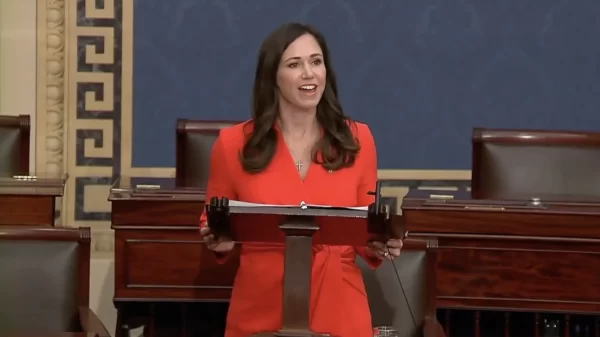On Wednesday, the Commonwealth Fund — a foundation dedicated to independent research on health care issues and addressing health care disparities — released its 2025 Scorecard on State Health System Performance, a report that tracks nationwide and state-by-state health care trends.
The report finds that while substantial progress has been made toward increasing health care coverage for all Americans, concerning trends — like increasing infant mortality, declining early childhood vaccination rates, and racial health disparities — are on the rise across the country. Additionally, the report’s authors note that the gains that have been made in reducing uninsured rates are currently under threat as congressional Republicans look to implement severe cuts to Medicaid, Medicare and the Affordable Care Act.
“The 2025 edition of the Scorecard on State Health System Performance once again demonstrates that when it comes to having affordable health coverage, access to good-quality care, and the ability to lead a healthy life, where you live matters,” reads the report’s overview. “In many cases, the wide variations in health and health care we see come down to the policy choices that state leaders make: for example, whether to expand Medicaid eligibility, whether to ensure women can access the full range of reproductive care services, or whether to boost investment in primary care.”
“Recent policy developments, however, could lead to fewer people with health insurance in all states,” the report goes on to state. “These include proposed Medicaid enrollment requirements; potential reductions in marketplace premium tax credits, which helped more than double plan enrollment after they were made more generous in 2021; and recent regulatory and proposed legislative changes that will eliminate marketplace eligibility for many people and make it much harder for those who need health insurance to enroll in marketplace plans and keep their coverage over time.”
For Alabama, these rollbacks could deal further harm to an already struggling health system. The report ranks Alabama 42nd out of the 50 states in its overall health system performance for 2025, and seventh out of the 12 states in the Southeast.
Alabama performs particularly poorly in the areas of access and affordability, healthy living, income disparity and racial health equity. When it comes to preventable hospitalizations ages 18-64 and maintaining up-to-date COVID-19 vaccinations, Alabama ranks dead last.
The report also notes that the 10 states who have failed to expand Medicaid, including Alabama, tend to have higher uninsured rates, while the states with the lowest uninsured rates and the biggest improvement since 2013 are “those that have fully implemented the Affordable Care Act, including its Medicaid eligibility expansion.”
Beyond the COVID-19 vaccine, Alabama struggles with vaccination writ-large. A greater percentage of children in Alabama go without all recommended vaccines than the national average, even as childhood vaccination rates decline across the country. The report’s authors note that vaccine skepticism may only grow worse as Secretary of Health and Human Services Robert F. Kennedy Jr. continues to spread misinformation about vaccine efficacy and dismantles federal support for vaccines.
“Recent actions by HHS on vaccine recommendations could fuel vaccine hesitancy and end insurance coverage for vaccines with proven efficacy and safety, leaving more children and adults unprotected from preventable illness and death,” said Commonwealth Fund senior scholar and vice president Sara Collins during a press briefing announcing the report.
The report also highlights the startling growth of infant mortality in several states. While Alabama’s infant mortality rate decreased slightly between 2018 and 2022, it remains above the national average. Racial disparities also persist in infant mortality nationwide, as black infants die at twice the rate of white infants due in-part to disparities within health care systems.
Similar racial disparities persist with regards to preventable deaths in general, with Black Americans — and Black Alabamians — dying from preventable causes at a disproportionate rate.
“Not only are deaths from avoidable causes more common in the U.S. than in other high-income countries, but rates have been increasing in the U.S. while decreasing in peer countries. Avoidable mortality is a measure of deaths before age 75 from certain infections, injuries, and illnesses, including diabetes and certain cancers, that are generally considered to be avoidable through strong primary and preventive care, early disease detection, and effective care management and treatment,” the report finds.
“Historically, Black Americans have been more likely to die early from avoidable causes compared to other groups,” it continues. “This held true in 2023: in every state, Black people had higher rates of avoidable death than people from other racial and ethnic groups.”
Alabama had over 355 preventable deaths per 100,000 individuals between 2022 and 2023, with the national average during the same period being 278 premature avoidable deaths per 100,000. Meanwhile, Black Alabamians died from preventable causes at nearly four times the lowest group mortality rate in the state during that time.
During Tuesday’s press briefing, the authors repeatedly emphasized how health outcomes continue to vary greatly across geographic regions in the U.S. While some regions like the Northeast are leading the way in generating positive health outcomes, the South continues to lag behind.
“The South has been really characterized by low rates of insurance coverage historically,” Collins noted. “That has improved substantially… but the South continues to lag in most states on insurance coverage.”
Collins added that while the South does continue to lag behind when it comes to health insurance coverage, the Affordable Care Act’s premium tax credits have helped to close that gap.
“I will say that we have seen enormous gains in enrollment in the marketplaces since the enhancement of the [ACA] premium tax credits in the marketplaces since 2021. So, Alabama and most states in the South that didn’t have Medicaid expansions really have seen enrollment just grow dramatically… And in fact, you see drops in the uninsured rates between 2019 and 2023 in our measures, primarily because of those more affordable tax credits.”
However, as the authors note in the report, the current Republican budget proposal would threaten to reverse these gains by allowing the premium tax credit to expire and by making Medicaid increasingly less accessible.
Kristen Kolb, a research associate at the Commonwealth Fund, added how lack of accessible health care contributes to worse overall health outcomes for Southern states like Alabama.
“Looking at some of the states, the performance on certain indicators, like our number of premature death from preventable causes, we can see, over time, disparities in access to insurance, access to health care services, how this has led to longer-term trends in indicators such as our preventable mortality. So, factors such as socioeconomic components and ensuring that people have access to to health care services that can change this in the future will be important to addressing the disparity between the South and other states,” Kolb stated.
The report concludes by demanding policy action from both states themselves and the federal government to improve national health care access and health outcomes as the U.S. falls behind other economically advanced countries.
The authors recommend that instead of imposing administratively-costly work requirements and increasing eligibility verification requirements, Congress should “ease enrollment barriers for eligible people and fill the Medicaid coverage gap, which affects low-income people who don’t qualify for either their state’s Medicaid program or subsidized marketplace coverage.”
Additionally, the authors criticize the Republican plan to allow the ACA premium tax credits to expire and the Trump administration’s proposed regulatory changes which could increase consumer costs and make enrollment significantly more difficult.
“To preserve the affordability of marketplace plans and prevent potentially millions from losing their coverage next year, Congress and the administration could extend the premium tax credits and avoid erecting new enrollment and cost barriers,” the authors suggest.
The authors’ other recommendations for policymakers include: instituting medical debt relief programs and banning aggressive collections policies; tying provider compensation to quality of care rather than volume of services; strengthening primary care; addressing vaccine hesitancy; expanding reproductive health care; expanding addiction care; and — last but not least — developing a national public health system.



















































